check engine MITSUBISHI SHOGUN 2008 Owner's Manual (in English)
[x] Cancel search | Manufacturer: MITSUBISHI, Model Year: 2008, Model line: SHOGUN, Model: MITSUBISHI SHOGUN 2008Pages: 538, PDF Size: 25.09 MB
Page 14 of 538
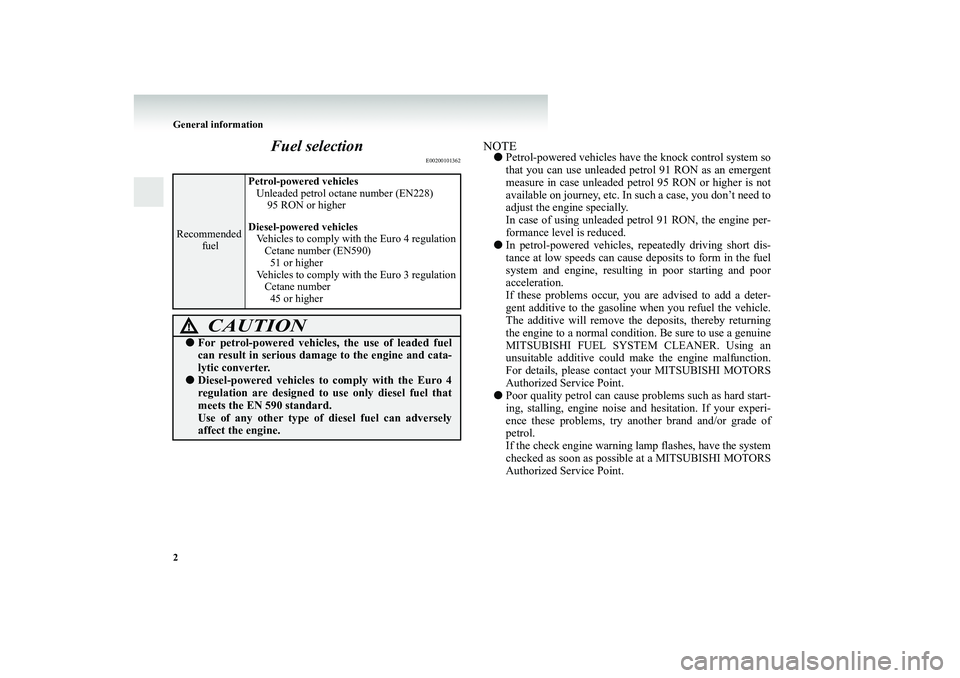
2 General information
Fuel selection
E00200101362
NOTE●
Petrol-powered vehicles have
the knock control system so
that you can use unleaded pe
trol 91 RON as an emergent
measure in case unleaded petrol
95 RON or higher is not
available on journey, etc. In
such a case, you don’t need to
adjust the engine specially. In case of using unleaded petrol 91 RON, the engine per- formance level is reduced.
●
In petrol-powered vehicles,
repeatedly driving short dis-
tance at low speeds can cause deposits to form in the fuel system and engine, resulting in poor starting and pooracceleration. If these problems occur, you
are advised to add a deter-
gent additive to the gasoline
when you refuel the vehicle.
The additive will remove the deposits, thereby returning the engine to a normal condition. Be sure to use a genuine MITSUBISHI FUEL SYSTEM CLEANER. Using anunsuitable additive could make the engine malfunction. For details, please contact your MITSUBISHI MOTORS Authorized Service Point.
●
Poor quality petrol can cause
problems such as hard start-
ing, stalling, engine noise and hesitation. If your experi- ence these problems, try another brand and/or grade ofpetrol. If the check engine warning lamp flashes, have the system checked as soon as possible at a MITSUBISHI MOTORSAuthorized Service Point.
Recommended
fuel
Petrol-powered vehicles Unleaded petrol octane number (EN228) 95 RON or higher Diesel-powered vehicles Vehicles to comply with the Euro 4 regulation Cetane number (EN590) 51 or higher Vehicles to comply with the Euro 3 regulation Cetane number 45 or higher
CAUTION
!●
For petrol-powered vehicles, the use of leaded fuel can result in serious damage
to the engine and cata-
lytic converter.
●
Diesel-powered vehicles to
comply with the Euro 4
regulation are designed to
use only diesel fuel that
meets the EN 590 standard. Use of any other type of
diesel fuel can adversely
affect the engine.
BK-BK2008E1ENUK.en-uk-Section3.fm Page 2 Wednesday, January 9, 2008 4:21 PM
Page 45 of 538
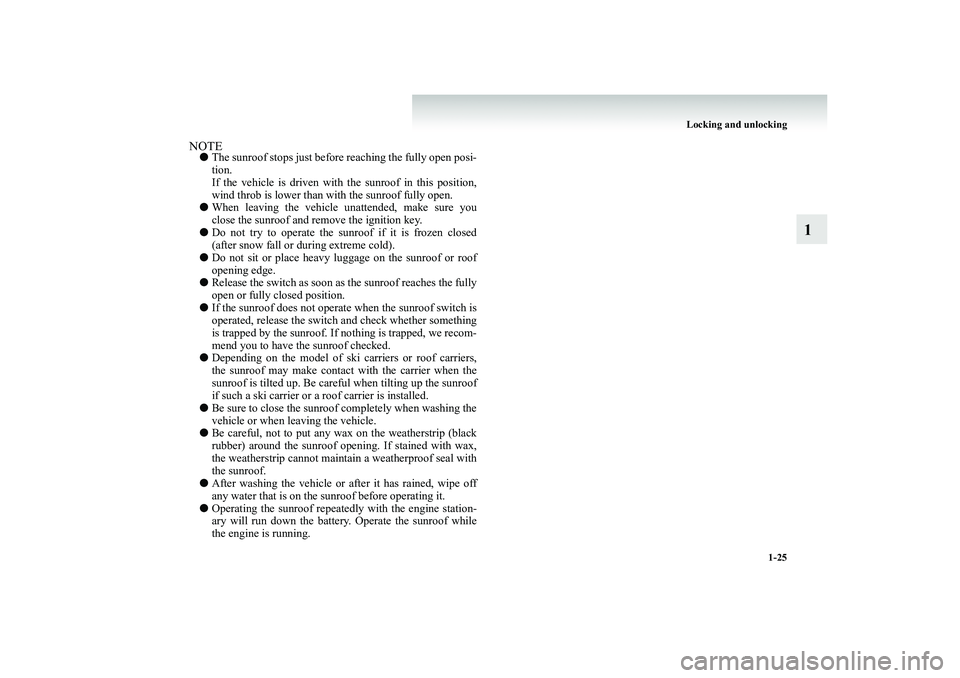
Locking and unlocking
1-25
1
NOTE●
The sunroof stops just before
reaching the fully open posi-
tion. If the vehicle is driven with the sunroof in this position, wind throb is lower than with the sunroof fully open.
●
When leaving the vehicle un
attended, make sure you
close the sunroof and remove the ignition key.
●
Do not try to operate the su
nroof if it is frozen closed
(after snow fall or
during extr
eme cold).
●
Do not sit or place heavy lu
ggage on the sunroof or roof
opening edge.
●
Release the switch as soon as the sunroof reaches the fully open or fully closed position.
●
If the sunroof does not operat
e when the sunroof switch is
operated, release the switch
and check whether something
is trapped by the sunroof. If no
thing is trapped, we recom-
mend you to have the sunroof checked.
●
Depending on the model of ski carriers or roof carriers, the sunroof may make contact
with the carrier when the
sunroof is tilted up. Be careful when tilting up the sunroofif such a ski carrier or a
roof carrier is installed.
●
Be sure to close the sunroof completely when washing the vehicle or when leaving the vehicle.
●
Be careful, not to put any wa
x on the weatherstrip (black
rubber) around the sunroof ope
ning. If stained with wax,
the weatherstrip cannot maintain a weatherproof seal withthe sunroof.
●
After washing the vehicle or after it has rained, wipe off any water that is on the sunroof before operating it.
●
Operating the sunroof repeated
ly with the engine station-
ary will run down the battery
. Operate the sunroof while
the engine is running.
BK-BK2008E1ENUK.en-uk-Section4.fm Page
25 Wednesday, January 9, 2008 4:22 PM
Page 134 of 538
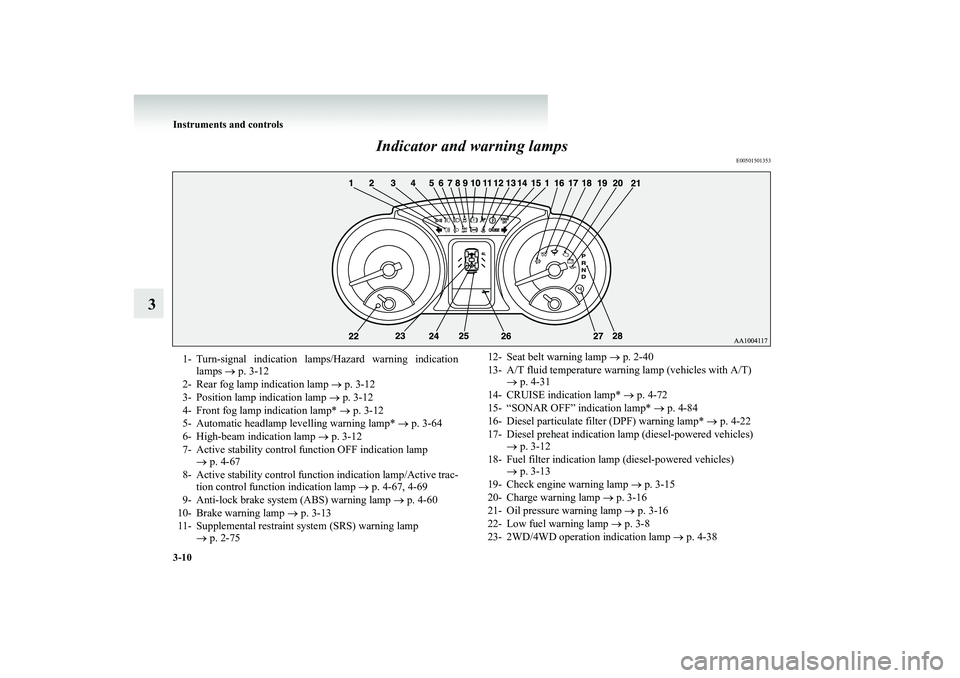
3-10 Instruments and controls
3
Indicator and warning lamps
E00501501353
1- Turn-signal indication lamps/Hazard warning indication
lamps
→ p. 3-12
2- Rear fog lamp indication lamp
→ p. 3-12
3- Position lamp indication lamp
→ p. 3-12
4- Front fog lamp indication lamp*
→ p. 3-12
5- Automatic headlamp levelling warning lamp*
→ p. 3-64
6- High-beam indication lamp
→ p. 3-12
7- Active stability control function OFF indication lamp
→ p. 4-67
8- Active stability control function indication lamp/Active trac-
tion control function indication lamp
→ p. 4-67, 4-69
9- Anti-lock brake system (ABS) warning lamp
→ p. 4-60
10- Brake warning lamp
→ p. 3-13
11- Supplemental restraint system (SRS) warning lamp
→ p. 2-75
12- Seat belt warning lamp
→ p. 2-40
13- A/T fluid temperature warning lamp (vehicles with A/T)
→ p. 4-31
14- CRUISE indication lamp*
→ p. 4-72
15- “SONAR OFF” indication lamp*
→ p. 4-84
16- Diesel particulate filter (DPF) warning lamp*
→ p. 4-22
17- Diesel preheat indication lamp (diesel-powered vehicles)
→ p. 3-12
18- Fuel filter indication lamp (diesel-powered vehicles)
→ p. 3-13
19- Check engine warning lamp
→ p. 3-15
20- Charge warning lamp
→ p. 3-16
21- Oil pressure warning lamp
→ p. 3-16
22- Low fuel warning lamp
→ p. 3-8
23- 2WD/4WD operation indication lamp
→ p. 4-38
BK-BK2008E1ENUK.en-uk-Section6.fm Page
10 Wednesday, January 9, 2008 4:32 PM
Page 137 of 538
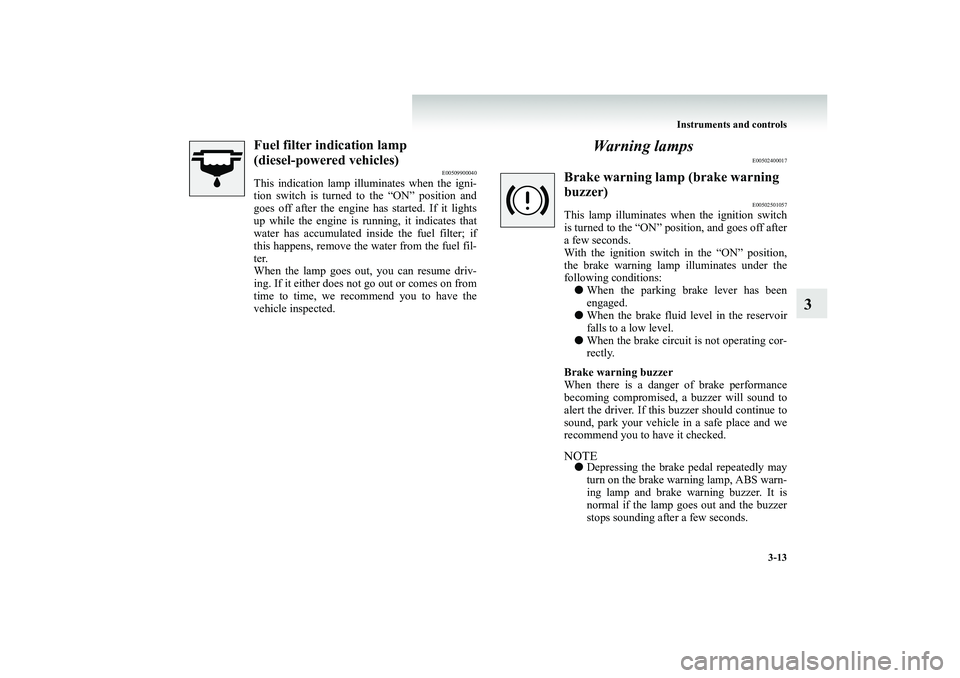
Instruments and controls
3-13
3
Fuel filter indication lamp (diesel-powered vehicles)
E00509900040
This indication lamp illuminates when the igni- tion switch is turned to the “ON” position andgoes off after the engine has started. If it lights up while the engine is ru
nning, it indicates that
water has accumulated inside the fuel filter; ifthis happens, remove the
water from the fuel fil-
ter. When the lamp goes out, you can resume driv-ing. If it either does not go out or comes on from time to time, we recommend you to have the vehicle inspected.
Wa r n i n g l a m p s
E00502400017
Brake warning lamp (brake warning buzzer)
E00502501057
This lamp illuminates when the ignition switch is turned to the “ON” position, and goes off after a few seconds.With the ignition switch in the “ON” position, the brake warning lamp illuminates under the following conditions:●
When the parking brake lever has been engaged.
●
When the brake fluid level in the reservoir falls to a low level.
●
When the brake circuit
is not operating cor-
rectly.
Brake warning buzzer When there is a danger of brake performance becoming compromised,
a buzzer will sound to
alert the driver. If this
buzzer should continue to
sound, park your vehicl
e in a safe place and we
recommend you to have it checked.NOTE●
Depressing the brake pe
dal repeatedly may
turn on the brake warning lamp, ABS warn- ing lamp and brake
warning buzzer. It is
normal if the lamp goes out and the buzzer stops sounding after a few seconds.
BK-BK2008E1ENUK.en-uk-Section6.fm Page
13 Wednesday, January 9, 2008 4:32 PM
Page 138 of 538
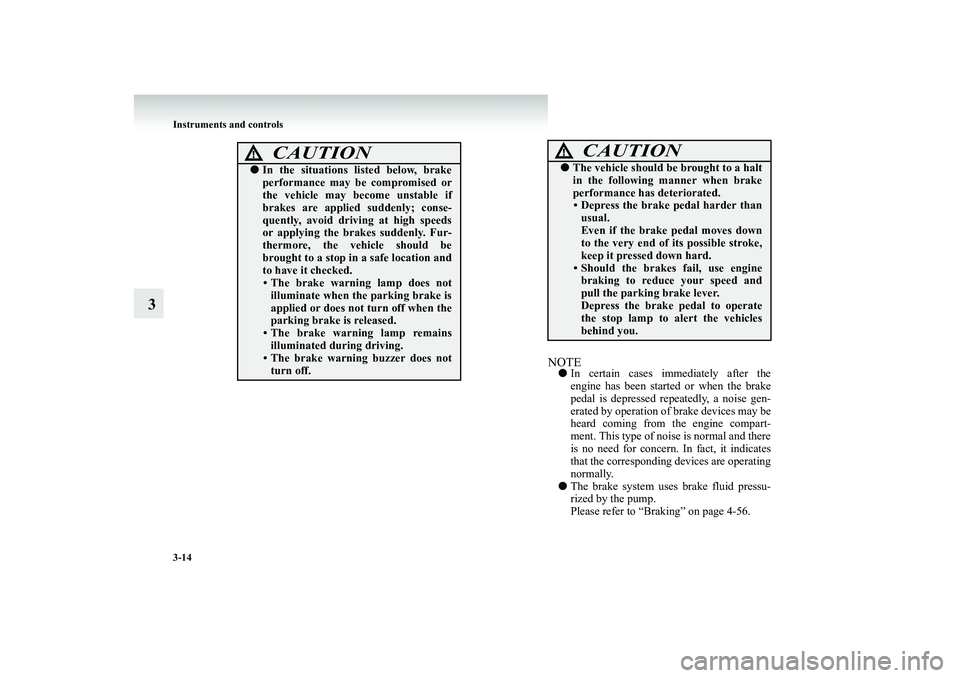
3-14 Instruments and controls
3
NOTE●
In certain cases immediately after the engine has been started or when the brake pedal is depressed repeatedly, a noise gen- erated by operation of brake devices may beheard coming from
the engine compart-
ment. This type of noise is normal and there is no need for concer
n. In fact, it indicates
that the corresponding devices are operating normally.
●
The brake system uses
brake fluid pressu-
rized by the pump. Please refer to “Braking” on page 4-56.
CAUTION
!●
In the situations listed below, brake performance may be compromised orthe vehicle may become unstable if brakes are applied suddenly; conse- quently, avoid driving at high speedsor applying the brakes suddenly. Fur- thermore, the vehicle should be brought to a stop in a safe location andto have it checked.• The brake warning lamp does notilluminate when the parking brake is applied or does not turn off when the parking brake is released.• The brake warning lamp remains illuminated during driving. • The brake warning buzzer does notturn off.
●
The vehicle should be brought to a halt in the following manner when brake performance has deteriorated.• Depress the brake pedal harder than usual. Even if the brake pedal moves downto the very end of its possible stroke, keep it pressed down hard. • Should the brakes fail, use enginebraking to reduce your speed and pull the parking brake lever. Depress the brake pedal to operate the stop lamp to
alert the vehicles
behind you.CAUTION
!
BK-BK2008E1ENUK.en-uk-Section6.fm Page
14 Wednesday, January 9, 2008 4:32 PM
Page 139 of 538
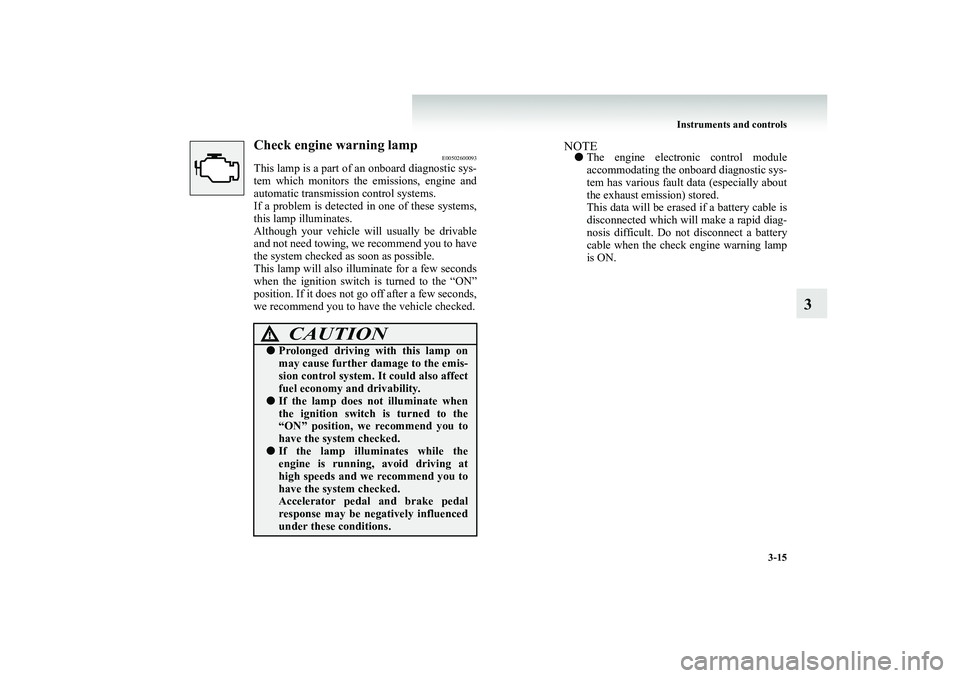
Instruments and controls
3-15
3
Check engine warning lamp
E00502600093
This lamp is a part of an onboard diagnostic sys- tem which monitors the emissions, engine and automatic transmission control systems. If a problem is detected
in one of these systems,
this lamp illuminates. Although your vehicle will usually be drivable and not need towing, we recommend you to havethe system checked as soon as possible. This lamp will also illuminate for a few seconds when the ignition switch is turned to the “ON”position. If it does not go off after a few seconds, we recommend you to have the vehicle checked.
NOTE●
The engine electr
onic control module
accommodating the onboard diagnostic sys- tem has various fault data (especially about the exhaust emission) stored.This data will be erased
if a battery cable is
disconnected which will make a rapid diag- nosis difficult. Do not disconnect a batterycable when the check engine warning lamp is ON.
CAUTION
!●
Prolonged driving with this lamp on may cause further damage to the emis- sion control system.
It could also affect
fuel economy and drivability.
●
If the lamp does not illuminate when the ignition switch is turned to the“ON” position, we recommend you to have the system checked.
●
If the lamp illuminates while the engine is running, avoid driving at high speeds and we recommend you to have the system checked.Accelerator pedal and brake pedal response may be negatively influenced under these conditions.
BK-BK2008E1ENUK.en-uk-Section6.fm Page
15 Wednesday, January 9, 2008 4:32 PM
Page 140 of 538
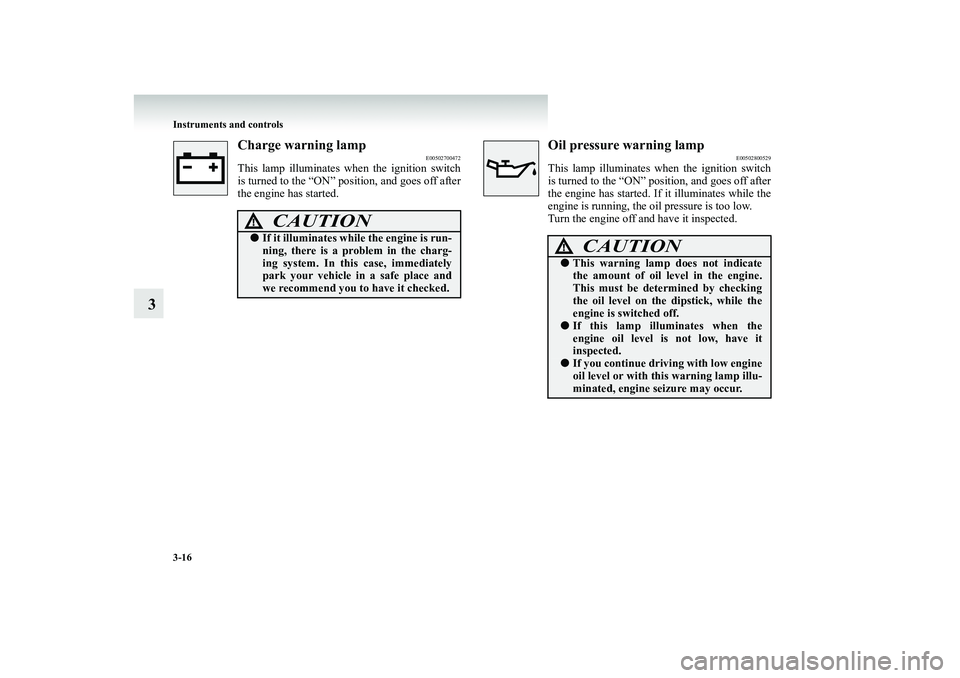
3-16 Instruments and controls
3
Charge warning lamp
E00502700472
This lamp illuminates when the ignition switch is turned to the “ON” position, and goes off after the engine has started.
Oil pressure warning lamp
E00502800529
This lamp illuminates when the ignition switch is turned to the “ON” position, and goes off after the engine has started. If it illuminates while the engine is running, the oil pressure is too low.Turn the engine off and have it inspected.
CAUTION
!●
If it illuminates while the engine is run- ning, there is a problem in the charg- ing system. In this case, immediatelypark your vehicle in a safe place and we recommend you to have it checked.
CAUTION
!●
This warning lamp does not indicate the amount of oil le
vel in the engine.
This must be determined by checking the oil level on the
dipstick, while the
engine is switched off.
●
If this lamp illum
inates when the
engine oil level is not low, have itinspected.
●
If you continue driving with low engine oil level or with this warning lamp illu-minated, engine seizure may occur.
BK-BK2008E1ENUK.en-uk-Section6.fm Page
16 Wednesday, January 9, 2008 4:32 PM
Page 182 of 538
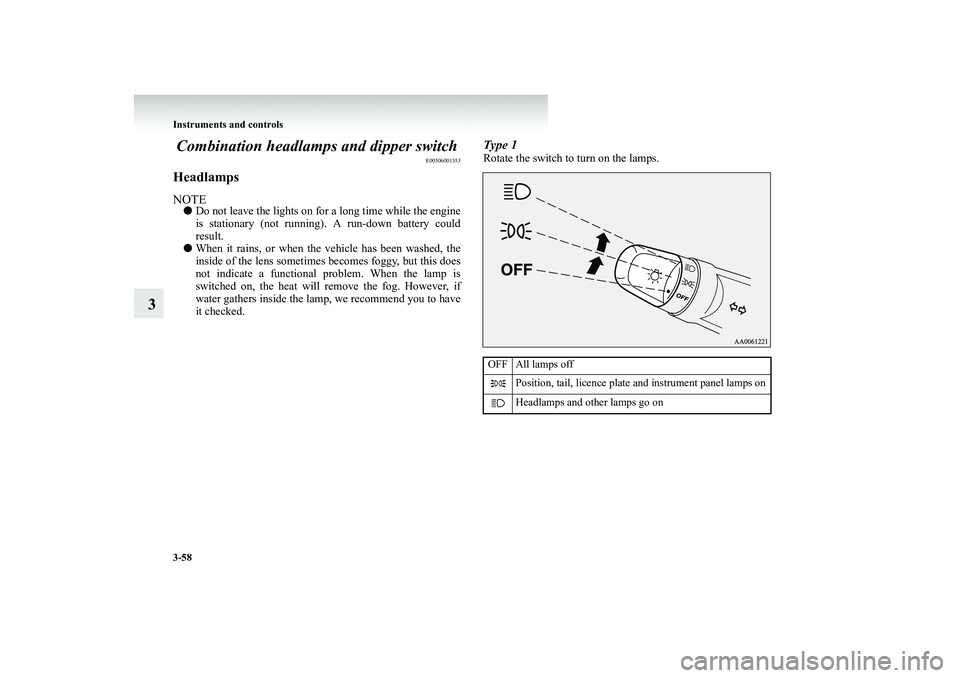
3-58 Instruments and controls
3
Combination headlamps
and dipper switch
E00506001353
HeadlampsNOTE●
Do not leave the lights on for a long time while the engine is stationary (not running). A run-down battery could result.
●
When it rains, or when the
vehicle has been washed, the
inside of the lens sometimes becomes foggy, but this does not indicate a functional pr
oblem. When the lamp is
switched on, the heat will
remove the fog. However, if
water gathers inside the lamp, we recommend you to have it checked.
Type 1Rotate the switch to turn on the lamps.OFF All lamps off
Position, tail, licence plate and instrument panel lamps on Headlamps and other lamps go on
BK-BK2008E1ENUK.en-uk-Section6.fm Page
58 Wednesday, January 9, 2008 4:32 PM
Page 204 of 538
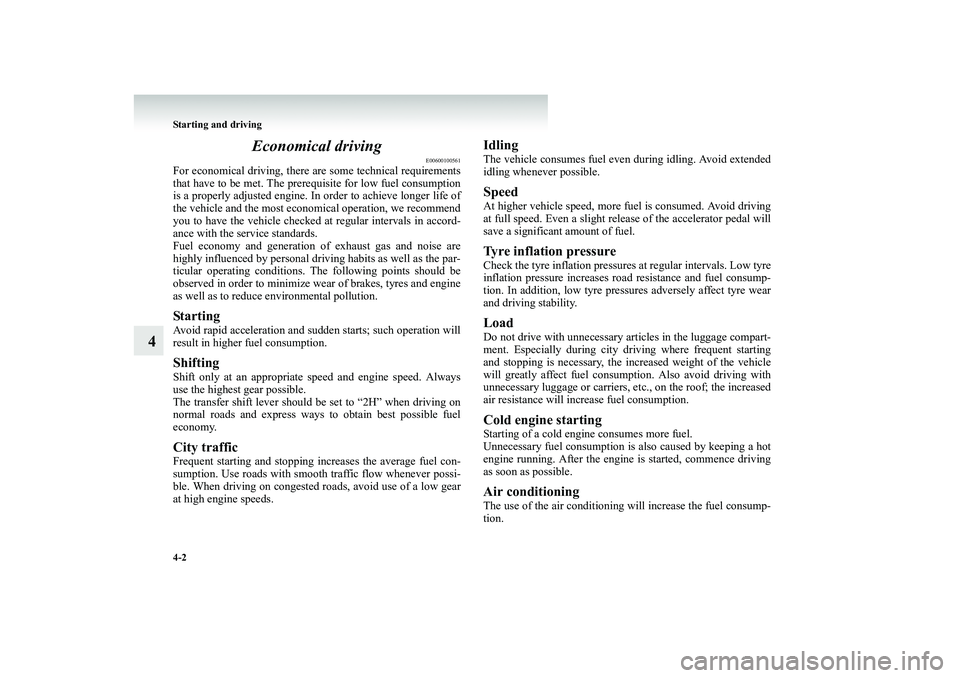
4-2 Starting and driving
4
Economical driving
E00600100561
For economical driving, there ar
e some technical requirements
that have to be met. The prerequisite for low fuel consumption is a properly adjusted engine. In order to achieve longer life ofthe vehicle and the most econo
mical operation, we recommend
you to have the vehicle checked
at regular intervals in accord-
ance with the service standards.Fuel economy and generation of exhaust gas and noise are highly influenced by personal driving habits as well as the par- ticular operating conditions. The following points should beobserved in order to minimize w
ear of brakes, tyres and engine
as well as to reduce environmental pollution.StartingAvoid rapid acceleration and sudden starts; such operation will result in higher fuel consumption.ShiftingShift only at an appropriate
speed and engine speed. Always
use the highest gear possible. The transfer shift lever should be set to “2H” when driving on normal roads and express ways to obtain best possible fueleconomy.City trafficFrequent starting and stopping
increases the average fuel con-
sumption. Use roads with smooth
traffic flow whenever possi-
ble. When driving on congested
roads, avoid use of a low gear
at high engine speeds.
IdlingThe vehicle consumes fuel even during idling. Avoid extended idling whenever possible.SpeedAt higher vehicle speed, more fu
el is consumed. Avoid driving
at full speed. Even a slight re
lease of the accelerator pedal will
save a significant amount of fuel.Tyre inflation pressureCheck the tyre inflation pressure
s at regular intervals. Low tyre
inflation pressure increases ro
ad resistance and fuel consump-
tion. In addition, low tyre pres
sures adversely affect tyre wear
and driving stability.LoadDo not drive with unnecessary articles in the luggage compart- ment. Especially during city dr
iving where frequent starting
and stopping is necessary, the increased weight of the vehicle will greatly affect fuel consumption. Also avoid driving with unnecessary luggage or carriers,
etc., on the roof; the increased
air resistance will increase fuel consumption.Cold engine startingStarting of a cold engine consumes more fuel. Unnecessary fuel consumption
is also caused by keeping a hot
engine running. After the engine is started, commence driving as soon as possible.Air conditioningThe use of the air conditioning
will increase the fuel consump-
tion.
BK-BK2008E1ENUK.en-uk-Section7.fm Page 2 Wednesday, January 9, 2008 4:36 PM
Page 221 of 538
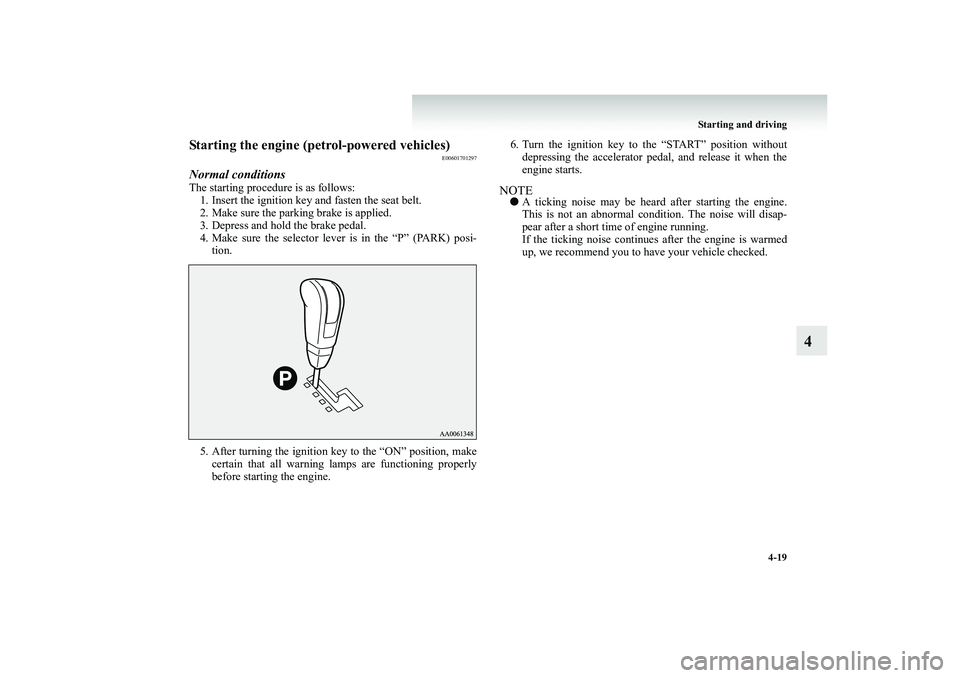
Starting and driving
4-19
4
Starting the engine (p
etrol-powered vehicles)
E00601701297
Normal conditionsThe starting procedure is as follows: 1. Insert the ignition key and fasten the seat belt. 2. Make sure the parking brake is applied.3. Depress and hold the brake pedal. 4. Make sure the selector lever is in the “P” (PARK) posi-
tion.
5. After turning the ignition key to the “ON” position, make
certain that all warning lamps are functioning properly before starting the engine.
6. Turn the ignition key to the “START” position without
depressing the accelerator pedal, and release it when the engine starts.
NOTE●
A ticking noise may be hear
d after starting the engine.
This is not an abnormal co
ndition. The noise will disap-
pear after a short time of engine running. If the ticking noise continues after the engine is warmedup, we recommend you to have your vehicle checked.
BK-BK2008E1ENUK.en-uk-Section7.fm Page
19 Wednesday, January 9, 2008 4:36 PM